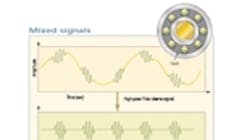Many serious machine problems can be diagnosed early with normal vibration analysis techniques based on fast Fourier transforms. But some problems remain dangerously hidden in the vibration reading — until it’s too late. These potentially catastrophic problems are caused by repeated high-energy impact events that occur at high frequency and very short duration. Typically associated with rolling-element bearing wear and gear meshing problems, they can be observed by demodulating, or enveloping key sections of a system’s vibration plot, and then applying fast Fourier analysis.
Questions & answers
Q: Why does fast Fourier transform analysis used alone display a haystack-shaped signal, instead of distinct peaks?
A: The FFT process looks for repeating sinusoidal components at individual frequencies so that amplitude as a function of time can be converted into a function of frequency. But because of the short duration and low amplitude of impact events, there isn’t energy for their peaks to stand out individually. The peaks harmonically related to the system’s impact period leak together for humps of amplitude in the frequency domain.
Q: Is it possible to tune in to the repetitive bursts of noise?
A: Yes. The resonant frequencies of a component on a running machine are always being excited. But when an impact occurs, its amplitude is modulated; in other words, it rings more loudly. (On a bearing, a roller hitting a fault acts as a striking gong; the bearing acts as the bell.) Envelope demodulation, also known as high-frequency enveloping, focuses in on the frequency being rung and (more importantly here) the rate at which it dilates. It then removes the high frequency of the ringing itself and returns the dilation rate. A window marks each burst frequency as a singular event. These events are then passed through the expedient fast Fourier decomposition technique to reveal the peaks and harmonics of the addenda sinusoids of the recurring event.
Q: How should demodulated results be interpreted?
A: By comparing the normal vibration and demodulated spectra, the condition of a part can be determined.
• No peaks in either indicate a healthy part.
• A peak in the demodulated spectrum indicates the beginning of wear.
• Peaks in both spectra indicate that the part should probably be replaced.
• Peaks in the normal spectrum combined with a rise in the demodulated noise floor indicates an imminent catastrophic failure.
This month’s handy tips were provided by National Electrical Carbon Products, Inc., Greenville, S.C.
